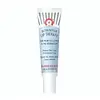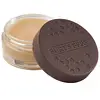What's inside
What's inside
 Key Ingredients
Key Ingredients

 Benefits
Benefits

 Concerns
Concerns

 Ingredients Side-by-side
Ingredients Side-by-side

Diisostearyl Malate
EmollientCera Microcristallina
Emulsion StabilisingSimmondsia Chinensis Seed Oil
EmollientButyrospermum Parkii Butter
Skin ConditioningVitis Vinifera Seed Oil
EmollientCopernicia Cerifera Wax
Glyceryl Diisostearate
EmollientDimethicone
EmollientAroma
Glycerin
HumectantTriisostearin
Skin ConditioningIsostearyl Alcohol
EmollientAvena Sativa Kernel Flour
AbrasiveHyaluronic Acid
HumectantMalic Acid
BufferingAllantoin
Skin ConditioningSqualane
EmollientTocopherol
AntioxidantGlycine Soja Oil
EmollientWater
Skin ConditioningChrysanthemum Parthenium Extract
Skin ConditioningGlycyrrhiza Glabra Root Extract
BleachingCamellia Sinensis Leaf Extract
AntimicrobialLeuconostoc/Radish Root Ferment Filtrate
AntimicrobialPhenoxyethanol
PreservativeEDTA
Citral
PerfumingLimonene
PerfumingDiisostearyl Malate, Cera Microcristallina, Simmondsia Chinensis Seed Oil, Butyrospermum Parkii Butter, Vitis Vinifera Seed Oil, Copernicia Cerifera Wax, Glyceryl Diisostearate, Dimethicone, Aroma, Glycerin, Triisostearin, Isostearyl Alcohol, Avena Sativa Kernel Flour, Hyaluronic Acid, Malic Acid, Allantoin, Squalane, Tocopherol, Glycine Soja Oil, Water, Chrysanthemum Parthenium Extract, Glycyrrhiza Glabra Root Extract, Camellia Sinensis Leaf Extract, Leuconostoc/Radish Root Ferment Filtrate, Phenoxyethanol, EDTA, Citral, Limonene
Caprylic/Capric Triglyceride
MaskingOleic/Linoleic/Linolenic Polyglycerides
EmollientC10-18 Triglycerides
EmollientGlycerin
HumectantSimmondsia Chinensis Seed Oil
EmollientGlyceryl Behenate
EmollientGlyceryl Stearate
EmollientHydrogenated Castor Oil
EmollientJojoba Esters
EmollientOctyldodecanol
EmollientHelianthus Annuus Seed Wax
Skin ConditioningCeramide NP
Skin ConditioningMentha Piperita Oil
MaskingCaramel
Cosmetic ColorantAcacia Decurrens Flower Wax
EmollientPolyglycerin-3
HumectantLimonene
PerfumingLinalool
PerfumingCaprylic/Capric Triglyceride, Oleic/Linoleic/Linolenic Polyglycerides, C10-18 Triglycerides, Glycerin, Simmondsia Chinensis Seed Oil, Glyceryl Behenate, Glyceryl Stearate, Hydrogenated Castor Oil, Jojoba Esters, Octyldodecanol, Helianthus Annuus Seed Wax, Ceramide NP, Mentha Piperita Oil, Caramel, Acacia Decurrens Flower Wax, Polyglycerin-3, Limonene, Linalool
 Reviews
Reviews

Ingredients Explained
These ingredients are found in both products.
Ingredients higher up in an ingredient list are typically present in a larger amount.
Glycerin is already naturally found in your skin. It helps moisturize and protect your skin.
A study from 2016 found glycerin to be more effective as a humectant than AHAs and hyaluronic acid.
As a humectant, it helps the skin stay hydrated by pulling moisture to your skin. The low molecular weight of glycerin allows it to pull moisture into the deeper layers of your skin.
Hydrated skin improves your skin barrier; Your skin barrier helps protect against irritants and bacteria.
Glycerin has also been found to have antimicrobial and antiviral properties. Due to these properties, glycerin is often used in wound and burn treatments.
In cosmetics, glycerin is usually derived from plants such as soybean or palm. However, it can also be sourced from animals, such as tallow or animal fat.
This ingredient is organic, colorless, odorless, and non-toxic.
Glycerin is the name for this ingredient in American English. British English uses Glycerol/Glycerine.
Learn more about GlycerinLimonene is a fragrance that adds scent and taste to a formulation.
It's found in the peel oil of citrus fruits and other plants such as lavender and eucalyptus. The scent of limonene is generally described as "sweet citrus".
Limonene acts as an antioxidant, meaning it helps neutralize free radicals.
When exposed to air, oxidized limonene may sensitize the skin. Because of this, limonene is often avoided by people with sensitive skin.
The term 'fragrance' is not regulated in many countries. In many cases, it is up to the brand to define this term. For instance, many brands choose to label themselves as "fragrance-free" because they are not using synthetic fragrances. However, their products may still contain ingredients such as essential oils that are considered a fragrance.
Learn more about LimoneneThis oil comes from the seeds of the desert shrub called Jojoba. It is more commonly known as jojoba oil, a non-comedogenic oil.
Jojoba oil does not contain fragrance and has many fatty-acids, making it a great soothing ingredient.
It also contains Vitamin E, a great moisturizing ingredient. Vitamin E is also an antioxidant and protects your skin against oxidative damage.
This ingredient humectant properties, meaning it helps draw moisture from the air. This helps keep your skin hydrated.
While jojoba has antibacterial properties, it is only able to kill some strains of bacteria.
Studies also show it helps in wound healing. In fact, Indigenous cultures have used jojoba as a moisturizer and to help treat burns for centuries.
Fun fact: Jojoba oil similar to natural human skin sebum, so it has a great effect on dry skin. It is also promising with helping to regulate sebum production.
Due to its fatty acid content, Jojoba oil may not be fungal acne safe. We recommend speaking with a professional if you have any concerns.
Learn more about Simmondsia Chinensis Seed Oil